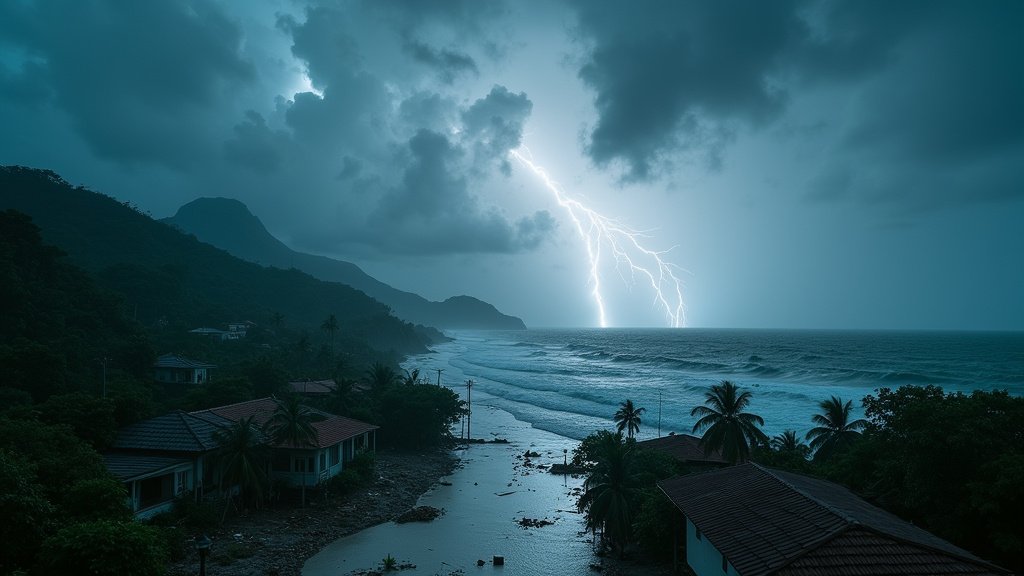Jamaica has been left reeling in the wake of Hurricane Melissa Jamaica, a monstrous Category 5 storm that made landfall on the island’s southwestern coast with unprecedented ferocity. This historic event, described by officials as the “storm of the century,” has brought widespread devastation, crippling infrastructure, and a humanitarian crisis as Jamaica disaster relief efforts begin.
A Storm of Unprecedented Fury: Hurricane Melissa Jamaica
Hurricane Melissa Jamaica, one of the strongest Atlantic hurricanes on record, slammed into Jamaica with maximum sustained winds of 185 mph (295 kph) on Tuesday afternoon, near New Hope, Jamaica. The storm’s immense power tore roofs off buildings, uprooted trees, and transformed roads into impassable rivers with torrential floodwaters. Boulders tumbled onto roadways, severely hampering movement and rescue operations. The island’s vital infrastructure has been “severely compromised,” with reports of significant Jamaica storm damage to hospitals, police stations, and other critical facilities.
A life-threatening Caribbean storm surge of up to 13 feet (4 meters) inundated the southern coast, with communities in St. Elizabeth parish described as “underwater”. The sheer volume of rainfall, with projections of 20 to 30 inches (500-750 mm) in many areas and potentially over 40 inches in isolated mountainous regions, has fueled catastrophic flash flooding and numerous landslides, further isolating communities. More than 530,000 Jamaicans were left without power as the storm battered the island’s electricity grid due to Hurricane Melissa Jamaica.
Record-Breaking Strength and Historical Context of Hurricane Melissa Jamaica
Hurricane Melissa Jamaica‘s intensity has etched its name into meteorological history. At landfall, its 185 mph winds tied the record for the strongest Atlantic storm at landfall, matching the Labor Day hurricane of 1935 and Hurricane Dorian in 2019. Its central pressure of 892 millibars also tied a record, placing it among the most intense Atlantic hurricanes ever recorded by pressure, trailing only Hurricane Gilbert and Hurricane Wilma. The storm’s slow movement, combined with abnormally warm ocean waters fueled by climate change, allowed it to maintain its catastrophic strength for an extended period, amplifying its destructive potential. This makes Melissa the strongest hurricane to make landfall in Jamaica since records began 174 years ago, a truly historic hurricane.
Human Impact and Fatalities from Hurricane Melissa Jamaica
The immediate human toll has been significant from Hurricane Melissa Jamaica. At least seven people have died across the Caribbean as a result of Hurricane Melissa, with three fatalities reported in Jamaica, three in Haiti, and one in the Dominican Republic. In Jamaica, initial deaths were attributed to trees falling during preparation efforts and electrocution. Officials warned that the situation was “extremely dangerous and life-threatening,” urging residents to stay in shelters until conditions improved.
Thousands of people were evacuated ahead of the storm’s arrival, with authorities in Jamaica preparing over 800 shelters and the government initially indicating plans to evacuate over 600,000 people. In Cuba, authorities evacuated more than 600,000 people in anticipation of Melissa’s passage, highlighting the broad impact of this Category 5 hurricane.
Official Response and International Aid for Hurricane Melissa Jamaica
The Jamaican government, led by Prime Minister Andrew Holness, declared the country a disaster area and mobilized resources for immediate relief and long-term Jamaica recovery efforts. The Jamaica Defence Force (JDF) called out the National Reserve to support humanitarian efforts, including search and rescue, logistics, and security in the face of Hurricane Melissa Jamaica. The government also launched a dedicated website, Support Jamaica (supportjamaica.gov.jm), to channel donations and coordinate recovery efforts.
International aid organizations are mobilizing rapidly. The World Food Programme (WFP), in collaboration with the International Organization for Migration (IOM) and other UN agencies like UNICEF, has initiated a sea-lift operation from Barbados, dispatching emergency food kits, solar lamps, hygiene kits, and shelter supplies. Agencies like the Red Cross, CARE, All Hands & Hearts, and Catholic Relief Services are also preparing to deploy resources to assist affected communities impacted by Hurricane Melissa Jamaica.
The Long Road to Recovery for Jamaica after Hurricane Melissa
Officials caution that cleanup and damage assessment will be a slow and arduous process due to the widespread Jamaica storm damage from Hurricane Melissa Jamaica. St. Elizabeth, known as the breadbasket of Jamaica, has been particularly hard-hit, raising concerns about the agricultural sector’s recovery and food security. The nation’s reliance on imports means that restoring supply chains will be crucial for long-term recovery.
Telecommunications company Flow is preparing to conduct damage assessments, noting that 61% of their sites are equipped with solar generators, though some fuel for generators was stolen prior to the storm. The Ministry of Health and Wellness is planning for vector control initiatives to prevent disease outbreaks like dengue in the aftermath of this devastating storm. Prime Minister Holness has outlined a multi-layered strategy for recovery, emphasizing the need for quick and effective post-disaster response, utilizing national disaster funds and insurance protections for Hurricane Melissa Jamaica.
As Jamaica grapples with the aftermath of Hurricane Melissa Jamaica, the scale of the devastation underscores the immense challenge ahead for rebuilding homes, infrastructure, and livelihoods. The news of this catastrophic event serves as a stark reminder of the growing intensity of tropical storms and the critical need for robust disaster preparedness and response mechanisms across the region, especially concerning record hurricane winds.

